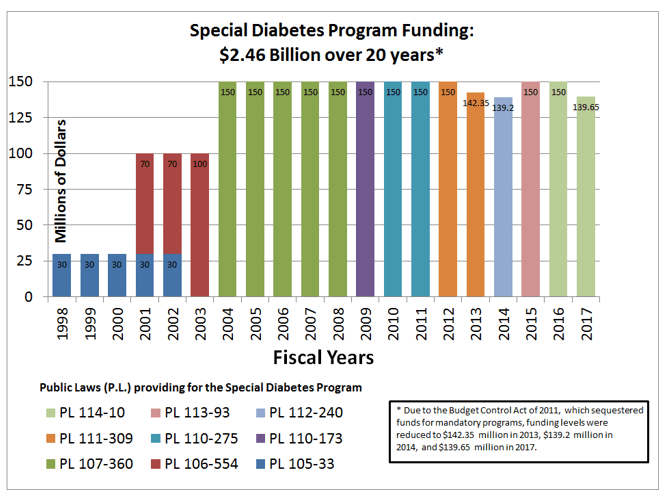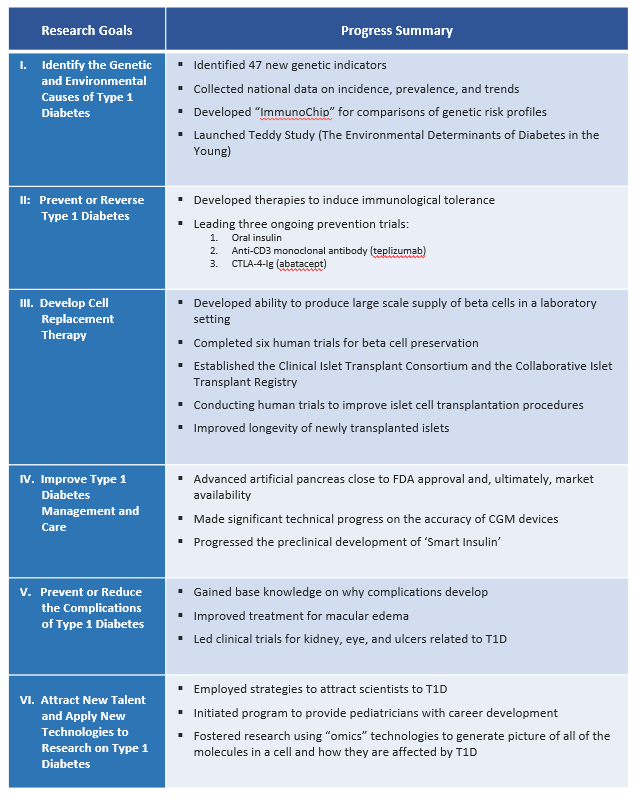
The United States government has set aside a budget each year since 2008 to support type 1 diabetes research, named the "Special Statutory Funding Program for Type 1 Diabetes Research." A progress report was released in June and key takeaways are summarized below.
Congress established this program to spur research that would prevent, cure, manage, and reduce complications of type 1 diabetes. It is administered by the National Institute of Diabetes and Digestive and Kidney Diseases (NIDDK), in collaboration with multiple NIH Institutes and Centers, the CDC, and the US Department of Health and Human Services. The program addresses six long-term goals which are discussed in greater detail along with progress highlights by goal in the table below. A link to the full NIH report can be found at the bottom of this summary.
SUMMARY POINTS:
- $2.4 billion has been spent since program inception in 1998.
- $150 million will be spent in 2016.
- While detailed, project-specific allocation information is not provided, the program shows a preference for funding large, multi-center projects, studies, and networks.
- Technology advances, such as the artificial pancreas and improved CGM devices, receive significant attention.
- There appears to be some importance attached to bringing solutions to market in the near term, but it does not appear to be a driving factor.
- Major areas of progress as noted in the NIH report:
- Blood Sugar Control Devices: Significant advances in the artificial pancreas (AP), insulin pumps, and CGM. AP is identified as being on a 'fast track' to FDA approval.
- Beta Cell Replacement: Advances in ability for large-scale laboratory production of functioning beta cells - but not yet testing in humans.
- Gene Identification: 50 different genes associated with risk of developing T1D are known, of which 47 were identified after 2013.
- Eye Disease Complications: Significant advances in new therapies.
- There are five active recruiting trials supported by the Special Diabetes Program as of July 2016; three focus on prevention and two focus on complications. Click the link provided at the conclusion of this report for specific details.
PROGRESS BY RESEARCH GOAL:

RELATED LINKS:
- Type 1 Diabetes Special Statutory Funding Program Homepage: https://www.niddk.nih.gov/about-niddk/research-areas/diabetes/type-1-diabetes-special-statutory-funding-program/Pages/default.aspx
- 2016 Special Statutory Funding Program for Type 1 Diabetes Progress Report: https://www.niddk.nih.gov/about-niddk/strategic-plans-reports/Pages/special-statutory-funding-program-for-type-1-diabetes-research-progress-report-2016.aspx
- Special Diabetes Program: Clinical Trials Recruiting Patients & Families: https://www.niddk.nih.gov/about-niddk/research-areas/diabetes/type-1-diabetes-special-statutory-funding-program/Clinical-Trials-Recruiting-Patients-Families/Pages/default.aspx
